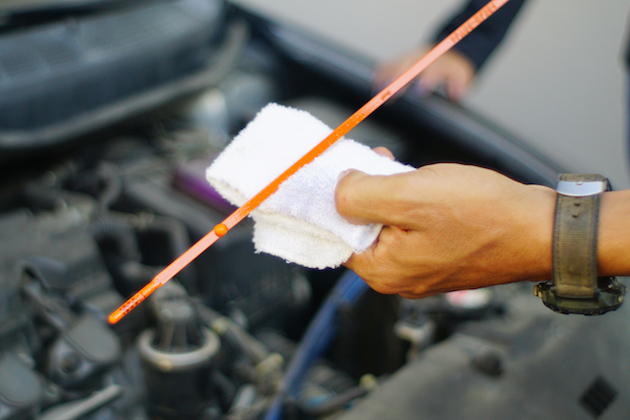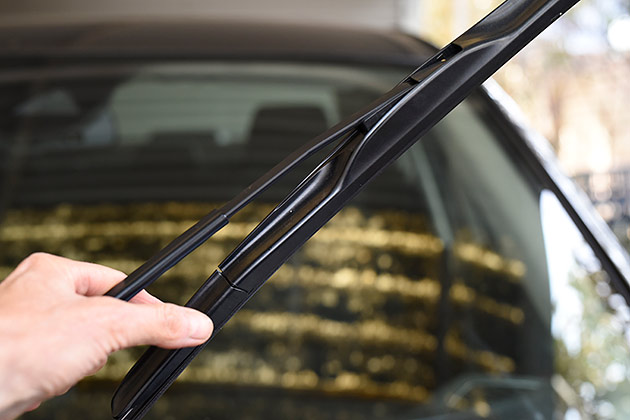According to our Roadside Assistance Patrols, many breakdowns and car problems could be avoided by doing a few simple car maintenance checks.
By checking things like oil, coolant levels, brake fluid, battery, windscreen washers and lights on a regular basis, you can keep your car in good condition—and help avoid expensive repair bills.
Here are seven simple checks to ensure your car is in tip-top shape.
Before you start working on your car, just remember to put on some gloves for protection.
1. Check and top up your engine oil
When checking your oil, make sure your car is on a level surface and the engine is cold.
First, remove the dipstick and wipe it with a clean cloth. Note the marks for high and low level.
Then, put the dipstick back in and remove it again, this time noting the oil level. If the oil level is not close to the higher mark, top up with a small funnel.
Wait a couple of minutes after adding oil before checking level again. This will allow oil to get down to sump and help ensure you don’t overfill.

2. Check and top up your coolant
Before you check your coolant, make sure your engine is off and the cooling system is cool.
Your car's coolant level will fluctuate with engine temperature—if you try to remove the coolant lid while the engine has the system under pressure, you could be severely burnt.
You can check your coolant level in the expansion bottle that is usually located close to the radiator. If you have trouble locating it, check your owner's manual.
Some cars have coolant overflow tanks that are not pressurised, so you should check coolant levels in there, too.
If your coolant level is low, top it up to the marked point.
And if you're having to regularly fill it up, get the system checked as you probably have a leak.
3. Clean your battery's terminals and top up electrolyte levels
It’s important to keep car battery terminals clean and dry, and electrolyte levels topped up.
First check tightness of terminals.
You can also check for acid build up, which will appear as a white powdery substance on your battery.
Safely clean acid build-up by sprinkling some bi-carb soda over the affected area, then drip some water over the top. You’ll see a foam develop, which will neutralise the acid. Then wipe the foam off the battery. Remember to wear gloves as the acid is corrosive.
Some car batteries are sealed for life and require no electrolyte top-up.
If your battery is the non-sealed type, however, you can check the level by removing the caps and ensuring the electrolyte covers the plates. Always top up with distilled water as tap water can contaminate the electrolyte and shorten the life of the battery.
When disconnecting the battery to clean the terminals, always disconnect the negative terminal first and reconnect it last.
RELATED:
Car battery maintenance tips »
4. Check your brake fluid level
Check to see if your brake fluid sits above the minimum mark. The fluid level should sit close to the maximum mark.
You don’t need to remove the cap to check brake fluid levels. You should be able to see where it sits from outside the clear container.
If you can’t see where the fluid is sitting, do the ‘wiggle test’ by shaking the car—this will help you see the fluid level more clearly.
Brake fluid levels should be checked on monthly basis. If you notice your brake fluid is low, or has dramatically reduced since your last check, get your car to the mechanic as soon as possible. If in doubt, get the vehicle towed as your brakes may have been compromised.
Also check the cap is securely fastened to the brake fluid container. If water gets inside, it can cause the brake fluid to boil under heavy braking conditions, leading to brake failure.
5. Check and top up your windscreen washer reservoir
Check your windscreen washer reservoir weekly. If it’s low on water, top up with clean tap water. Adding a windscreen solvent will also help prevent road grime build-up.
Never use household washing-up liquid or detergents in the reservoir—they can cause blockages, damage the windscreen wipers, and produce bubbles which will obscure your vision while driving.
You can adjust and clean your washer jets with a small needle. Just be careful not to damage the nozzles.
Make sure you also regularly clean your windscreen with a glass cleaner.

6. Check your front and rear vehicle lights
If your lights are not working, your car is not roadworthy and you could be subject to a fine.
You can check the front lights of your vehicle yourself, but you may need some help checking the rear lights.
Replacement light globes can be purchased from most service stations. Check your handbook for information on the correct type and installation procedure.
7. Check your tyres
Check your tyres regularly, particularly before a long drive.
When inspecting your tyres, check the tread depth and tyre pressure.
The legal limit for tyre tread is 1.5mm. There are in-built wear indicator bars on the tyre to help you see when your tyres need to be replaced.
Tyre pressure should be checked every couple of weeks. You can do this check using the free air pressure gauge at your local service station.
Do this check when the tyres are cool to get a more precise reading. You can find the correct tyre pressure on the tyre itself, on a placard in the inside of your car door, or in the vehicle manual.
RELATED:
How to read car tyre markings »
Save on your next car service RAC members save 10% on labour at our nine auto service centres, conveniently located across Perth and in Mandurah.
Last updated: May 2024
